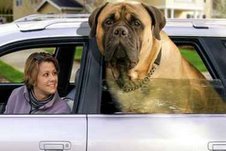
Most dog owners will notice any sudden or odd changes in their dogs normal behaviour but it is useful to know the specific symptoms to watch out for.
If you dog shows symptoms of excessive drinking, sudden loss of appetite, continual vomiting or diarrhoea, or unusual
lethargy then these should be obvious enough to raise your concern.
Discharge from the eyes or inflamed eyes, a shallow or rapid breathing pattern or perhaps persistent coughing can all be signs of something serious.
Typically when a dog is sick or ill they will show a raised temperature, indicated by a hot, dry nose. If your dog has a high temperature or even a very low temperature you should seek professional advice from your veterinarian.
Do be aware that a dog's temperature will be raised after strenuous activity or excitement and will not therefore be a reliable indication to its health.
If you are unsure you can take your dogs temperature yourself and this is taken rectally with a suitable thermometer. A dogs normal resting temperature is 101.5F, although if your dog is a hairless breed their temperature could be one or two degrees higher.
To take your dogs temperature choose a time when your dog is calm. You will need to ensure your dog is firmly held to prevent them from sitting down onto the thermometer. Smear the thermometer with vaseline or suitable lubricant and insert it into your dogs rectum about an inch.
Any reading above 102.5F or any reading below 100F should be regarded with concern and veterinarian advice should be sought.
If you known or feel your dog is ill make sure you keep them calm and display a reassuring manner until you get them to the veterinarian. Dogs can be very sensitive to your tone of voice and will pick up any worry or anxiety in your voice and manner.
Understanding your dogs needs and keeping a watchful eye for symptoms of sickness and ill health will ensure you can take swift action and ensure you dog is cared for sooner than later.
For further advice on looking after your dog or puppy, visit Dog and Puppy Care.
For full details on dog training, care, health and diet, visit Dog and Puppy Training, Care, Health and Diet.
Article Source: http://EzineArticles.com/?expert=Jack_Prime
Discharge from the eyes or inflamed eyes, a shallow or rapid breathing pattern or perhaps persistent coughing can all be signs of something serious.
Typically when a dog is sick or ill they will show a raised temperature, indicated by a hot, dry nose. If your dog has a high temperature or even a very low temperature you should seek professional advice from your veterinarian.
Do be aware that a dog's temperature will be raised after strenuous activity or excitement and will not therefore be a reliable indication to its health.
If you are unsure you can take your dogs temperature yourself and this is taken rectally with a suitable thermometer. A dogs normal resting temperature is 101.5F, although if your dog is a hairless breed their temperature could be one or two degrees higher.
To take your dogs temperature choose a time when your dog is calm. You will need to ensure your dog is firmly held to prevent them from sitting down onto the thermometer. Smear the thermometer with vaseline or suitable lubricant and insert it into your dogs rectum about an inch.
Any reading above 102.5F or any reading below 100F should be regarded with concern and veterinarian advice should be sought.
If you known or feel your dog is ill make sure you keep them calm and display a reassuring manner until you get them to the veterinarian. Dogs can be very sensitive to your tone of voice and will pick up any worry or anxiety in your voice and manner.
Understanding your dogs needs and keeping a watchful eye for symptoms of sickness and ill health will ensure you can take swift action and ensure you dog is cared for sooner than later.
For further advice on looking after your dog or puppy, visit Dog and Puppy Care.
For full details on dog training, care, health and diet, visit Dog and Puppy Training, Care, Health and Diet.
Article Source: http://EzineArticles.com/?expert=Jack_Prime










